David Weber, Talei Kunkel, Rose Harrison and, Fatima Remtulla Solutions for Chapter: Bivariate Data What it Means to be Human, Exercise 13: Practice 2
David Weber Mathematics Solutions for Exercise - David Weber, Talei Kunkel, Rose Harrison and, Fatima Remtulla Solutions for Chapter: Bivariate Data What it Means to be Human, Exercise 13: Practice 2
Attempt the practice questions on Chapter 5: Bivariate Data What it Means to be Human, Exercise 13: Practice 2 with hints and solutions to strengthen your understanding. MYP Mathematics A concept-based approach 3 solutions are prepared by Experienced Embibe Experts.
Questions from David Weber, Talei Kunkel, Rose Harrison and, Fatima Remtulla Solutions for Chapter: Bivariate Data What it Means to be Human, Exercise 13: Practice 2 with Hints & Solutions
Ours is the only species to be able to communicate ideas to others through a written language. This ability also allows humans to express their creativity, which is another characteristic that is typically human. The recording and exchange of ideas using the written word is an important part of how we pass information on from one generation to the next. The average time spent reading at various ages is given in the table below.
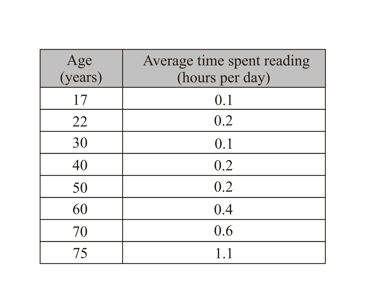
Suggest a reason for the relationship you described in between a person's age and the average number of hours they spend reading each day.
Ours is the only species to be able to communicate ideas to others through a written language. This ability also allows humans to express their creativity, which is another characteristic that is typically human. The recording and exchange of ideas using the written word is an important part of how we pass information on from one generation to the next. The average time spent reading at various ages is given in the table below.
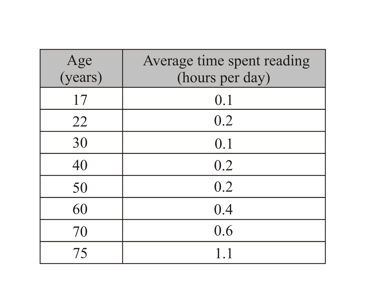
Does getting older cause a person to read more? Explain.
Abraham Maslow, a famous psychologist, created a hierarchy of human needs. He said that humans must fulfil their basic needs, like the need for food and water, before experiencing higher-order needs. Higher-order needs include those related to self-esteem (e.g. the need to feel confident) and to self-actualization (e.g. the desire to be creative or to find purpose in life). While many species share the lower-order needs, it is humans alone who can strive to be the best that they can be. The data in the table below relates to the human need for safety.
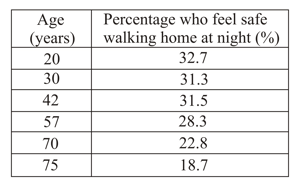
Represent the data using a scatter plot.
Abraham Maslow, a famous psychologist, created a hierarchy of human needs. He said that humans must fulfil their basic needs, like the need for food and water, before experiencing higher-order needs. Higher-order needs include those related to self-esteem (e.g. the need to feel confident) and to self-actualization (e.g. the desire to be creative or to find purpose in life). While many species share the lower-order needs, it is humans alone who can strive to be the best that they can be. The data in the table below relates to the human need for safety.
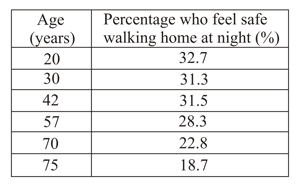
Draw the line of best fit and find its equation. Write the equation in standard form .
Abraham Maslow, a famous psychologist, created a hierarchy of human needs. He said that humans must fulfil their basic needs, like the need for food and water, before experiencing higher-order needs. Higher-order needs include those related to self-esteem (e.g. the need to feel confident) and to self-actualization (e.g. the desire to be creative or to find purpose in life). While many species share the lower-order needs, it is humans alone who can strive to be the best that they can be. The data in the table below relates to the human need for safety.
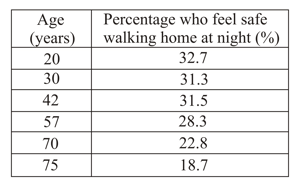
Use your equation of the line of best fit to predict the percentage of students of age who would feel safe walking home at night.
Abraham Maslow, a famous psychologist, created a hierarchy of human needs. He said that humans must fulfil their basic needs, like the need for food and water, before experiencing higher-order needs. Higher-order needs include those related to self-esteem (e.g. the need to feel confident) and to self-actualization (e.g. the desire to be creative or to find purpose in life). While many species share the lower-order needs, it is humans alone who can strive to be the best that they can be. The data in the table below relates to the human need for safety.
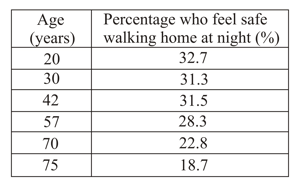
Do you agree with your calculation in prediction of the percentage of students of age who would feel safe walking home at night, using the equation of line of best fit. Explain.
Abraham Maslow, a famous psychologist, created a hierarchy of human needs. He said that humans must fulfil their basic needs, like the need for food and water, before experiencing higher-order needs. Higher-order needs include those related to self-esteem (e.g. the need to feel confident) and to self-actualization (e.g. the desire to be creative or to find purpose in life). While many species share the lower-order needs, it is humans alone who can strive to be the best that they can be. The data in the table below relates to the human need for safety.
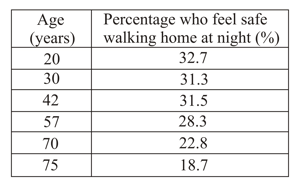
Describe in words the relationship between a person's age and the likelihood he feels safe walking home at night.
Abraham Maslow, a famous psychologist, created a hierarchy of human needs. He said that humans must fulfil their basic needs, like the need for food and water, before experiencing higher-order needs. Higher-order needs include those related to self-esteem (e.g. the need to feel confident) and to self-actualization (e.g. the desire to be creative or to find purpose in life). While many species share the lower-order needs, it is humans alone who can strive to be the best that they can be. The data in the table below relates to the human need for safety.
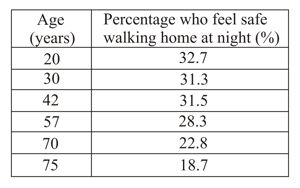
Does getting older cause a person to feel less safe walking alone? Explain.
